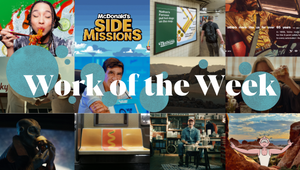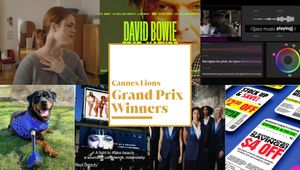
5 Minutes with… Greg Greenberg

Photo credit: Mariona Vilarós
After more than 14 years at TBWA\Media Arts Lab, Greg Greenberg has become one of the key creative forces behind Apple’s most iconic modern day advertising. As executive creative director, a role he has held since the beginning of 2021, he currently leads campaigns for iPhone and Apple Vision Pro - work defined by its innovation, precision, and emotional resonance.
From the dynamic choreography of AirPods spots like 'Bounce' to the delicate storytelling of 'Heartstrings', Greg’s body of work reflects a deep commitment to craft and narrative pacing. His recent work continues to push creative boundaries - whether through the highly awarded cinematic metaphor of 'Flock' or the immersive storytelling of 'Submerged' for Apple Vision Pro, which hints at the future of spatial computing.
But Greg’s influence runs deeper than the work itself. A long-time champion of mentorship and creative culture at MAL, he’s helped shape the next generation of talent, many of whom now lead major Apple campaigns. That blend of creative consistency, brand loyalty, and people-first leadership makes Greg’s journey one worth exploring.
So, LBB's Addison Capper did just that.
LBB> You've spent 14-and-a-half years at MAL. That's a long time! It's rare for a creative to stay at any agency that long, let alone on the same client. What has kept you inspired and energised over that period?
Greg> In my opinion, all creatives want three things: the opportunity to do great stuff on great briefs, ambition, and trust.
The first two are easier to find. There are various brands and agencies that have opportunity and ambition. But I think trust takes time. Trust with an agency, trust with the people I work with, trust with Apple – it takes working on a brand for a long time, repeatedly doing great work, so that you can then bring ideas that maybe aren't fully baked or you aren't even sure if it will work or not. That trust is what allows you to have the room to push the boundaries and do great stuff.
So, what's kept me is the fact that I have all three of those. I haven't ever found a reason to leave, because it allows me to do the kind of stuff that, when I was a lot younger, I always wanted.
LBB> How do you feel that continuity has shaped the way you approach creative work?
Greg> We don't chase trends in the work. And the comfort I have in both the challenges and the opportunities we get to work on allows us to just focus on what we feel is great – our instincts. We're never really looking at what other people are doing. I think when you're coming into new places all the time, or you're at certain agencies, you tend to try to make a mark quickly by emulating either the work you think they want or what happens to be popular at the time in the industry. And that's never been how I've done it. It's never been what any of our teams have done. That's certainly not what MAL or Apple do.
I think it's because of the long relationships, not just mine. You look at our president, our CCO – they've been there a really long time. I think it's not necessarily just about advertising, but about the opportunities and the trust you get. I think you do great work when you know something, when it's part of who you are as much as it is your job. That lends itself to better stuff.
So for me, it's the time spent, the trust, and the continuity that has led to the best work.
LBB> There’s so much recent work I could’ve asked about, but let’s start with ‘Flock’ - a beautifully cinematic spot with a serious product message. It feels like classic Apple. Can you talk us through how it came together?
Greg> I remember the brief was very sharp and focused, and that's always a great starting point. When we, along with Apple, know exactly what we're going after right from the beginning, that's great. And then the product itself is great too. At the end of the day, yes, there are creative challenges, but when you can start in a place like that, it's really refreshing.
We were able to be sharp, to have a bit of attitude – and that gave the creatives a really strong foundation to work from. I remember we had a lot of good ideas in the concepting phase, but nothing that felt truly memorable at first.
Then, at some point, one of them just hit. I think about concepts like imagining a gif – what's the sticky image people will remember? One of the creatives mocked up an image of seagulls, like how they often sit on rocks by the ocean. But instead of seagulls, it was security cameras. The caption was something like 'rats of the sky'. That was it.
When I saw that image, I just thought that it would get attention immediately. People's attention is so limited, and if you can create an image that instantly lands, like the camera birds, it sticks.
That was the starting point. And it's a pretty weird, out-there idea. But it goes back to the trust we've built over time working with Apple – being able to bring something like that to the table and not be laughed out of the room. It wasn't, 'Why would we ever do this?' It was, 'That's memorable.'
And then all the craft and fun stuff came in to really make it special. But originally, it was just that little image. That was it.
LBB> That image is the idea, right?
Greg> That image is the idea. But then you get to the next stage. We worked with Legacy Effects, who are the people that did the original ‘Alien’. They design creatures practically; they have a workshop and build everything by hand. They were the ones who figured out what we want these things to actually look like.
There were different 'species' – ones that live by the sea would be more rusted, others would hang down like bats. We became amateur ornithologists. We had to study bird behaviour, and then ask ourselves how we translate that into these cameras.
LBB> ‘Submerged’ is a really different piece. Can you tell me about that project the way you did with ‘Flock’? What kind of different challenges come with working in that way?
Greg> It's always exciting to be given an opportunity to work on something where you're on the bleeding edge of tech, and the evolution of filmmaking, frankly. ‘Submerged’ was a shared effort between Apple Marcom, the Vision Pro Group and Media Arts Lab. A first-of-its-kind collaboration with many talented humans who all contributed massively. This one was really special, and really difficult, because we were kind of making the first real big film for that medium while still learning how to shoot for it. It was a process of figuring it out, and at the same time, the output from that process still needed to be great.
From conception to release, it was probably over a year of work. First, we had to understand the idea, then find who wanted to make it with us. We spent a lot of time working with that crew, learning the camera system, testing a lot in London for weeks before we even started writing the script.
We had to learn what worked and what didn't. That informed the story, which our director Edward Berger then wrote – and then rewrote when things didn't work. The tech really did drive a lot of the storytelling.
Then we got to the actual making of it, and production design became a huge challenge. In a normal film set, you can put anything off-camera – lights, equipment, whatever. But because it's 180-degree filming, you can't do that. The only way to light a scene is practically, within the set. So the lights that are part of the set also have to be the ones lighting the actors.
Everything became a challenge. The cameras had to be hidden so you wouldn't catch them in the periphery, because they capture everything in such high definition. Every little detail matters. Stuff that would look great on traditional film looks fake if it's even slightly off in Vision Pro – it's so crisp. For example, we had to source real parts from World War Two submarines, because if we used replicas, you'd be able to tell.
Then there's the acting. If you've ever watched a film on one of those super high-def TVs, sometimes it looks like reality TV – something just feels off. In this format, if the acting isn't incredible, it looks fake. The actors are right up in your face, so they have to hold a presence and really deliver. There's no room for error.
It was thrilling, but really tough. We had to learn so much just by doing it. These films are the marketing for the product. They're meant to inspire people to think, this is what the future is going to be.
LBB> Sound design and pacing are really important parts of the process for you. Can you talk about why that is, and how you think about those elements during the creative process?
Greg> I think it goes back to craft. We're noodlers – in a good way. Ideas need to be simple, but the things that go into making them often have to be, or can be, very complex to make it feel effortless.
Sound, for me, is something I really harp on. Whether it's in the mix or the design, the smallest things can – from an emotional level – maybe only raise it 1 or 2%, but that's the difference between someone slightly tearing up and someone actually crying.
For example, in 'Heartstrings' we worked with a great sound designer to authentically represent hearing loss. And that's hard – it's difficult to replicate something you don't personally experience, especially in a way that feels true to a community that will absolutely call BS if it's not right.
We were asking, how can we be as authentic as possible? And the sound designer used a binaural microphone – it can actually record the sound inside your head. We tried to use real sound from inside the human head to represent that experience as closely as possible.
It's the same with ‘Flock’. All the little details mattered. We were out in a junkyard recording weird creaks and groans because those birds were made of rusted metal. So we said, let's go move some rusted metal. Let's be as authentic as we can.
Those things may not stand out explicitly – most people watching don't know what sound design is. But they feel it. It transmits something. You feel it as a human being, even if you can't explain exactly why.
LBB> I wanted to ask you more generally about craft. On top of many other things, Apple advertising is known for having an extremely high level of craft in almost every way possible. But craft is also quite a big word! How would you define craft in the context of the work?
Greg> I think craft is a broad term, but the word I'd point to is care – caring about every little detail. When you do that, that care is transmitted to people in a way where they can feel that someone took the time to make something great. They might not know every aspect of how it was done, but they feel it.
I always tell our teams that we have to care about every aspect of the work. It's not enough that it's a great idea. It's not enough that it was shot beautifully. Every element has to be considered. If six parts are great and one isn't, the whole thing might just end up being good, but never amazing.
Once you have a really simple, great idea, it's all those decisions – the small ones – that either elevate it or don't. That's the moment where craft comes in. And honestly, more work often goes into making it than coming up with it. Sometimes the idea comes really easily – it's the execution that's significantly harder.
I feel really proud when I look at the teams that have come up under me and see how much they care – even when I'm not telling them to. Whether it's building a deck to present or crafting an idea, they're in the weeds, paying attention to every detail.
That mindset teaches discipline. It affects how you think about everything – not just the work, but the process of getting there.
As an agency, we care deeply about it. And obviously, Apple does too – from marketing to product. Just look at the product design. That's care. Years of care go into every element of what they create. We have to match that.
LBB> How do you foster that culture of consistency and ambition on such a long-running account?
Greg> I'm lucky in the sense that at MAL and Apple the history alone is incredibly inspiring. Not just the recent work – there's a very intimidating and very large legacy of great work and great partnership. If you can't come in inspired by that from the start, it's probably going to be a pretty tough road.
So I think we're lucky – everyone who joins comes in with a lot of ambition and a drive to do the best work of their career. My job is really to push them in the right direction. Having been here and done it myself, I help lead and channel that energy and ambition in the right way. I don't find it hard to keep people motivated.
I always tell people: if you can give two or three great years, focus on that. I promise your career and your book will be infinitely better for it.
So yes, there's work to do in guiding and developing people, but inspiring them? That's the easy part. They come in ready to do amazing stuff. My role is to help shape their ambition and inspiration into work that's great, that's right for the brand, and that Apple deserves.
LBB> What have you learned about your own creative growth from sticking with one brand for so long?
Greg> When I talk to younger creatives, I often say that it's really easy to want to jump around. And sometimes that's because it fast-tracks your title or your salary – and I'm not knocking that path. That works for a lot of people.
But if you want longevity, I think you have to build relationships. You have to really learn the brand you're working on – not just to do great work one year, but to keep doing great work year after year. That's been a key learning for me.
I come from a family like that. My mom was a teacher for 35 years. My dad's a lawyer and has been at the same firm for 42 years. Some of that mindset probably came from osmosis, just growing up around it. But even when I was in New York doing the whole jump-around-to-different-places thing, I never really liked it. Every time you start somewhere new, you've got to learn the people, the personalities, the brands. It takes time just to get comfortable – and only then was I able to focus on doing great work.
I feel lucky now that I don't have to think about all that. I just get to focus on the work – is this great or is it not? And I think that's what every creative wants: to boil it down to that one question. When you remove all the distractions that come with constantly moving around, it becomes simpler to do the best work of your life.
Read more 5 Minutes with... interviews here.
Read more from Addison Capper here.















